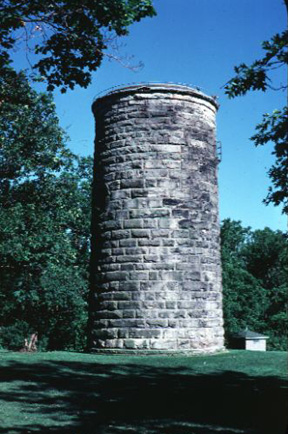Waterworks TowerMorgan, 1893 |

This was the state of the art in waterworks at the turn of the century. The opening of the Parsons Road reservoir in 1961 turned it into a historical relic. The vaguely archaeological aura of its pigeon-spattered stonework inspires many fancy tales about its origin. Some call it Oberlin's answer to Stonehenge.
The complex dates from the 1880s, when concern about polluted wells and cisterns and the threat of typhoid fever persuaded village authorities to plan a safe, modern municipal water system. Adequate reserves for fighting fires were also hoped for. Careful surveys ended in a decision to tap the Vermilion River for a pure supply. A team of Italian immigrant ditch diggers, imported from Pittsburgh, worked through the summer of 1887, laying the connections between river, reservoir, pump house, and village subscribers. Though homeowners were slow to sign up, the system went into operation by Christmas, and its capacity expanded steadily thereafter. The 40-foot stone tower, topped by a tall steel storage tank, was completed in 1893, and a second reservoir was added in 1916. In 1903 waterworks trustees installed a municipal lime-soda water softening plant, touted as the first in the United States. Pleasant landscaping and forestation of the surrounding acres, and the technical advances built into the facilities, brought wide renown to the waterworks in the early decades of this century.
Obsolescence has improved the enigmatic charm of the stone tower. It continues to excite curiosity among newcomers and tourists, who wonder what mysterious purposes it might serve. Only the pigeons know for sure.
(Blodgett 136)